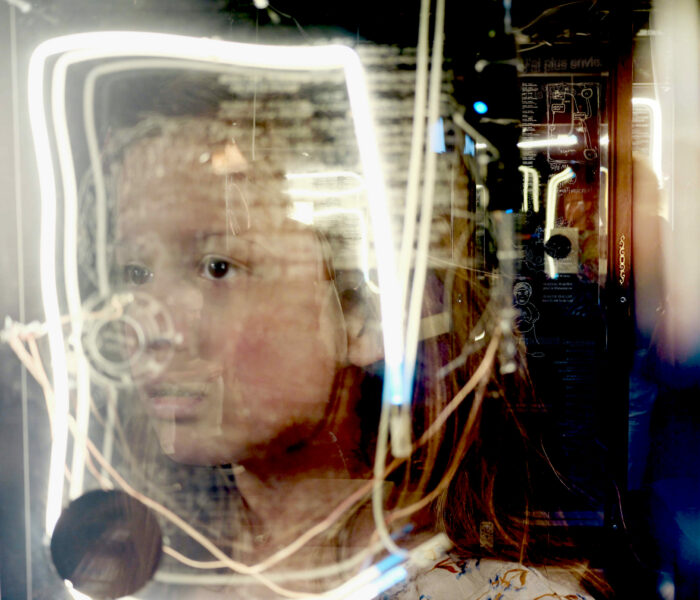Créer des sons à partir des signaux émis par les satellites zombies qui continuent d’émettre, mystérieusement, en orbite : voilà l’idée, étonnante et poétique, concrétisée par Stéfane Perraud et Aram Kebabdjian avec Hystérésia, une installation qui entame une tournée européenne.
Ils s’appellent Oscar 11, Les-five, les Solrades, Isis, Alouette ou encore Akébono ; ils sont 31 et ce sont des satellites zombies, entendez des satellites qui ne fonctionnent plus, aussi appelés « ruines célestes », mais qui continuent d’orbiter et d’émettre des sons. Des objets aussi poétiques que technologiques qui avaient de quoi attirer l’attention de l’artiste plasticien Stéfane Perraud, féru de science-fiction et de physique et de son complice, l’écrivain et dramaturge, Aram Kebabdjian. Ensemble, ils conçoivent Hystérésia, à la fois installation sonore et outil de performance, qui était présentée au Mudac à Lausanne jusqu’en février 2024 et qui va entamer un circuit en France – dans le cadre de la prochaine Nuit Blanche à Paris, à la Gaîté Lyrique, probablement en tournée en Corse à l’été – et en Belgique, au Pavillon à Namur.
Dialogue avec l’au-delà
Les deux artistes travaillent ensemble depuis dix ans. « Nous sommes très intéressés par la notion de déchet, d’archéologie technologique… et par la période de la Guerre froide », explique Stéfane Perraud qui est déjà l’auteur d’une « Machine à dessiner » qui récupère des ondes militaires et les transforme en dessin, chaque jour. Mais ceci est une autre histoire.
« Hystérésia est une façon de faire chanter ces déchets célestes et de conter l’histoire oubliée de ces fantômes technologiques, poursuit-il. Hystéréria évoque l’effet d’hystérésie. ‘Hystéros’, en grec, c’est ce qui vient après. L’effet d’hystérésie désigne la persistance d’un effet quand la cause a disparu. »
En l’occurrence, la persistance des signaux que ces satellites morts continuent d’émettre depuis l’espace, et plus précisément depuis les orbites cimetières, lieux où ils sont localisés. « De quoi sont-ils encore la mémoire? Qu’ont-ils encore à nous dire ? Ces objets soulèvent des questions philosophiques passionnantes ! » poursuit Aram Kebabdjian. Or, il ne s’agit pas seulement d’écouter les sons émis par ces satellites, mais de les traiter pour les transformer en matériau artistique.
hystérésia-installation-mudac from Aram Kebabdjian on Vimeo.
Faire chanter les modulations du satellite
Les deux artistes ont travaillé sur ce projet pendant près de huit ans. « Nous voulions créer un synthétiseur des sons émis par ces satellites zombies. Ces bruits ont une telle potentialité, ils ouvrent l’imaginaire et le champ des possibles… », explique Stéphane Perraud. Hystérésia est ainsi présentée comme « un observatoire sonore des satellites zombies ». L’œuvre, grâce à son logiciel, recherche en direct, de façon automatisée, des signaux radios résiduels de ces satellites qui datent, pour la plupart d’entre eux, de la Guerre froide, et les font entendre au public grâce à ses trois pavillons. Le logiciel construit par Stéfane et son équipe travaille à partir d’une éphéméride : « Nous savons dix jours à l’avance à quelle heure et à quelle fréquence les 31 satellites vont passer et émettre. Le logiciel suit et capte le signal, les ondes, comme une radio. Là, le signal est traité, ‘dé-noiser’, et un séquenceur donne à entendre le son brut du satellite et, petit à petit, va essayer de le faire chanter à partir d’une partition que nous avons écrite. Ce sont des effets simples, comme des réverbérations, des saturations. »

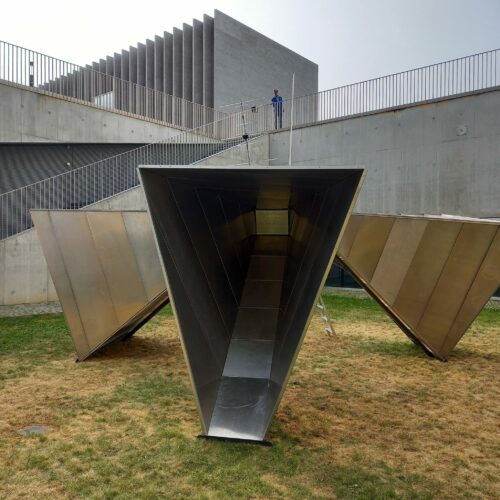

Histoires polyphoniques
Le son est au cœur de la démarche : pendant que ces bruits et oscillations de satellites sont émis, l’histoire de chacun d’entre eux est racontée par plusieurs voix de femmes enregistrées. Aram Kebabdjian a écrit ces textes à partir de recherches documentaires et a tissé toute une polyphonie : « Entre cinq et dix textes, en français, sont associés à chacun des satellites. Ces textes sont de plusieurs types : certains retracent un pan de l’histoire de ces satellites, satellites militaires, espions, de géolocalisation, météo, de télévision… Toutes les fonctions des satellites sont représentées avec ces 31 spécimens. Mais je ne m’en tiens pas à la date de décollage du satellite et à sa mission, nous avons poussé plus loin l’imaginaire. Mon préféré est peut-être Transit 5b-5, le plus ancien, qui date de 1964, et que l’on surnomme ‘le satellite chantant‘ tant le son délicat ressemble à celui d’un oiseau électronique ! »
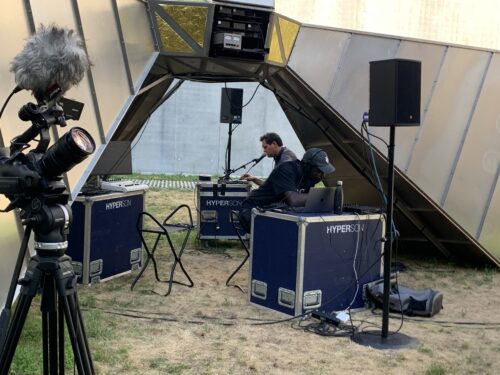
Expérimentations noise
Plus qu’une installation, Hystérésia est l’occasion de diverses performances autour de la noise : « Nous sommes plasticien et écrivain, insiste Aram. Cela nous semblait indispensable d’amener des musiciens à s’emparer des ondes pour créer de la musique avec, pour les intégrer à leur musique. » Artistes sonores et musiciens sont ainsi régulièrement invités, comme Aho San à Lausanne.
hystérésia-live performance-Aho Ssan- @mudac from Aram Kebabdjian on Vimeo.
Le public lausannois s’est montré très curieux. « Les mots zombie et satellite intriguent fortement les gens, sans compter l’aspect de l’installation, qui évoque un ovni ! » confie Aram. Hystérésia invite, au-delà de la découverte de l’histoire singulière – parfois rocambolesque – de chacun de ces satellites, véritables témoins, voire protagonistes, de l’Histoire, à tendre l’oreille et à tourner le regard vers le ciel, « lieu de toute éternité dans les diverses mythologies », rappelle Stéfane. Traductrice de sonorités mystérieuses, l’installation devient passerelle vers la création.
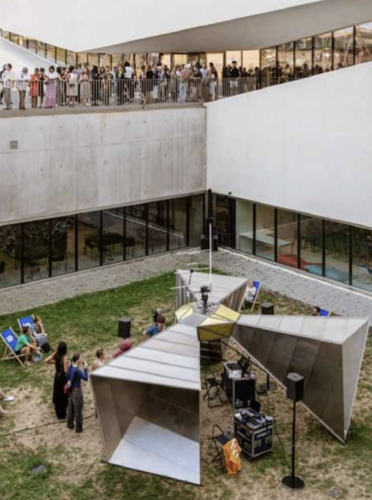
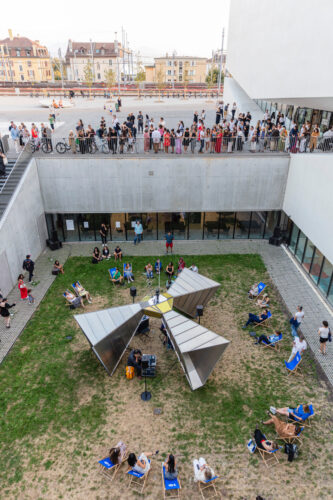
Suzanne Gervais
Photos © Stéfane Perraud
Photos © Anquetil Bijan
Photos © Étienne Malapert



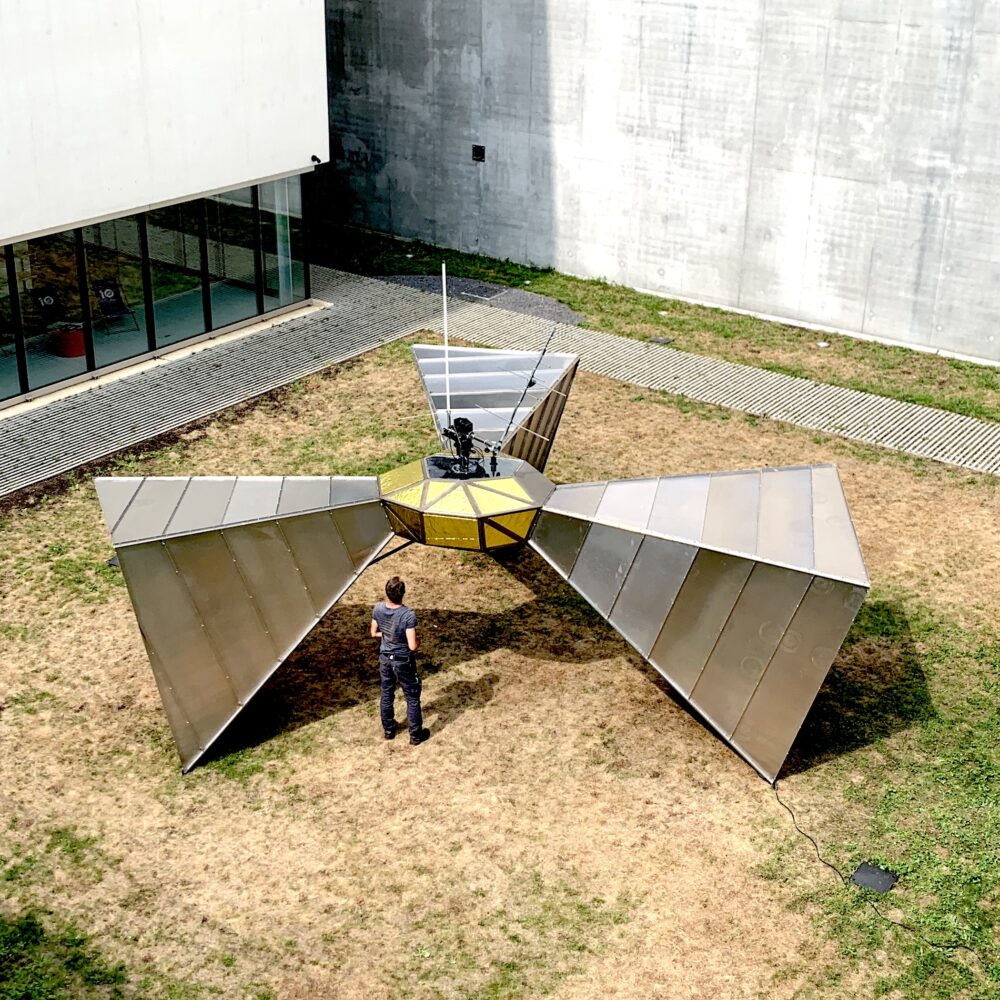)
